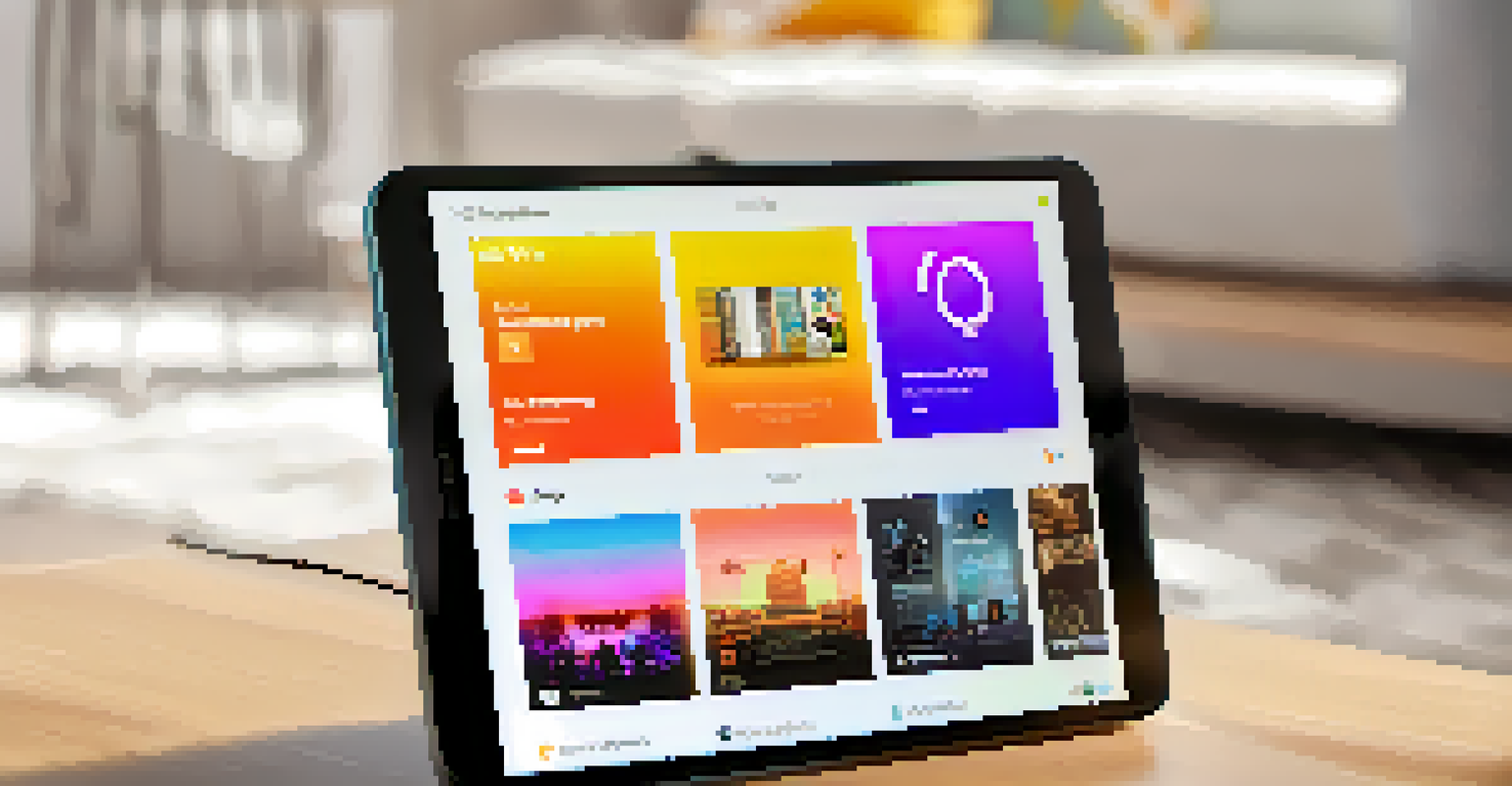The Impact of the Internet on Music Distribution

The Dawn of Digital Music Distribution
The rise of the internet marked a significant shift in how music was distributed. Gone were the days when physical media like CDs dominated the market. Instead, artists began to leverage digital platforms to reach their audiences directly. This democratization of music distribution allowed independent musicians to gain visibility without the need for major record labels.
Music is the shorthand of emotion.
With platforms like Napster emerging in the late '90s, the concept of music sharing transformed the industry overnight. Although it raised legal concerns, it paved the way for new models of distribution that favored accessibility over exclusivity. This shift not only made music more available but also introduced listeners to a broader range of genres and artists.
Overall, the early days of digital music distribution set the stage for a revolution that was just beginning. Artists and fans alike were eager to explore this new landscape, leading to innovations we see today in streaming and online sales.
The Rise of Streaming Platforms
One of the most significant developments in music distribution has been the emergence of streaming platforms like Spotify and Apple Music. These services allow users to access vast libraries of music for a monthly fee, effectively changing the way people consume music. Instead of purchasing individual tracks, listeners can explore entire catalogs with ease.

Streaming platforms have also introduced algorithms that personalize music recommendations, making it easier for users to discover new artists. This has been a game-changer for musicians, as exposure to new audiences can lead to increased fan engagement and concert attendance. In fact, many indie artists have credited platforms like Spotify with helping them build their careers.
Digital Music Distribution Revolution
The internet has transformed music distribution, enabling artists to reach audiences directly and democratizing access to diverse genres.
However, the rise of streaming has also sparked debates about fair compensation for artists. While it has opened up new avenues for exposure, many argue that the revenue generated per stream is insufficient for artists to sustain their livelihoods. This ongoing conversation highlights the complexities of the modern music distribution landscape.
Social Media's Role in Music Promotion
Social media has become an essential tool for artists to promote their music and connect with fans. Platforms like Instagram, TikTok, and Twitter enable musicians to share snippets of their work, engage with followers, and create buzz around new releases. This direct line of communication fosters a sense of community and allows fans to feel more connected to their favorite artists.
The great thing about digital music is that it brings artists and fans closer together than ever before.
Additionally, viral trends on social media can catapult songs to success overnight. A catchy dance challenge on TikTok, for instance, can lead to millions of streams and newfound fame for the artist involved. This phenomenon demonstrates how the internet has not only changed distribution but also the promotional landscape of music.
However, the reliance on social media can also place pressure on artists to constantly produce content. Balancing creativity with the demands of maintaining an online presence can be challenging, raising questions about the sustainability of this model for long-term success.
The Impact of Online Music Retailers
Online music retailers like Bandcamp and SoundCloud have provided artists with platforms to sell their music directly to fans. This shift has allowed musicians to retain a larger share of their earnings compared to traditional distribution models. With the ability to set their own prices and offer merchandise, artists can better control their financial futures.
Moreover, these platforms often cater to niche audiences, allowing genres that might not receive mainstream attention to flourish. For example, indie and underground artists can find dedicated fan bases without needing to conform to commercial trends. This diversity enriches the music landscape and gives listeners access to a broader range of sounds and stories.
Rise of Streaming Platforms
Streaming services have changed music consumption by offering vast libraries for a monthly fee, but they also raise concerns about fair artist compensation.
However, the success of such platforms relies heavily on effective marketing strategies. Artists must leverage social media, email lists, and other tools to drive traffic to their pages. This additional layer of responsibility can be daunting, especially for musicians who want to focus primarily on their art.
Global Accessibility of Music
The internet has also played a crucial role in making music accessible to audiences around the world. No longer limited by geographical boundaries, listeners can explore diverse musical traditions and genres from different cultures. This global reach has enriched the music experience, allowing for cross-cultural collaborations and fusion genres.
For instance, artists from different countries can easily connect and create music together, resulting in unique sounds that blend various influences. This not only enhances the listening experience but also promotes cultural exchange and understanding. The ability to access international music has led to the rise of genres like K-pop and Afrobeat on the global stage.
However, this accessibility also means that artists face increased competition. With countless musicians vying for attention, standing out in a crowded marketplace can be challenging. As a result, artists must continually innovate and adapt to capture the interest of listeners worldwide.
The Role of Analytics in Music Distribution
Analytics tools have become indispensable for artists and record labels in the digital age. By analyzing listener data, musicians can gain insights into their audience's preferences and behaviors. This information can guide marketing strategies, tour planning, and even the creation of new music, helping artists make informed decisions.
For example, if an artist notices a spike in streams from a particular city, they may decide to schedule a concert there. Similarly, understanding which songs resonate most with their audience can influence their future releases. This data-driven approach has transformed the way music is marketed and distributed.
Social Media's Promotional Power
Social media platforms allow artists to engage with fans and promote their music, but the pressure to constantly produce content can be overwhelming.
Nonetheless, an over-reliance on analytics can stifle creativity. Artists may feel pressured to produce music that aligns with listener preferences rather than exploring their artistic vision. Striking a balance between data insights and creative expression is essential for sustainable success in the music industry.
Challenges and Controversies in Digital Distribution
While the internet has revolutionized music distribution, it has also introduced challenges and controversies. Issues such as copyright infringement, streaming royalties, and the impact of algorithms on exposure have sparked ongoing debates within the industry. Artists often find themselves navigating a complex landscape as they seek to protect their work and earn fair compensation.
For instance, the controversy surrounding platforms like YouTube has raised questions about the fairness of monetization for artists. Many musicians argue that the revenue generated by ad-supported streams is insufficient to sustain their careers. Additionally, the algorithms used by streaming services can favor certain genres or artists, leaving others struggling for visibility.

As the industry continues to evolve, these challenges will likely remain at the forefront of discussions about the future of music distribution. Finding solutions that benefit both artists and listeners will require collaboration and innovation across the board.
The Future of Music Distribution in a Digital World
Looking ahead, the future of music distribution is likely to be shaped by ongoing technological advancements. As virtual reality, augmented reality, and artificial intelligence continue to develop, new opportunities for music engagement and distribution will emerge. Imagine attending a virtual concert where you can interact with the artist and fellow fans from around the globe.
Moreover, as blockchain technology gains traction, it may offer solutions to some of the industry's biggest challenges, such as fair compensation and copyright issues. This could lead to a more equitable system for artists and a more transparent distribution process. The potential for innovation is vast, and the music industry is poised for exciting changes.
Ultimately, the impact of the internet on music distribution has been profound, and its evolution will continue to shape the way we experience music. Both artists and listeners must adapt to these changes, embracing new technologies and platforms that redefine the musical landscape.